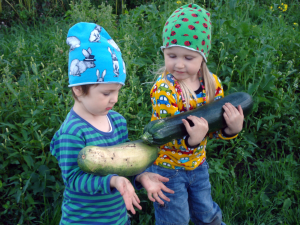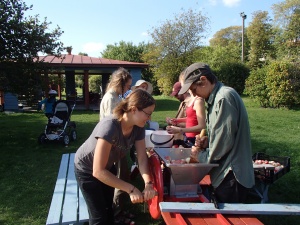Family gardening club
Description

The main idea of the family gardening club activities at the Kumpula School Garden is to offer families in the city an opportunity to participate in guided organic gardening and community activities. The goal is to learn how to garden and enjoy the summer with the delicious harvest from the soil. The club operates in a traditional milieu, Kumpula School Garden, where school vegetable garden activities have taken place without interruption since 1920.
In the spring, the families make the rows ready for sowing by tilling the soil, and then they sow the seeds with the children or plant the small seedlings into the soil. The sown areas are marked, watered and covered with frost cloth, if necessary. During the summer, people take care of the garden together: weeding, watering, using mulch, thinning out plants, supporting plants that need it, and harvesting. The harvest is gathered throughout the summer, and it is shared between the club members to take home.
The activities are based on doing things together, supporting growth and learning, and the power of a diverse garden. In the gardening club, the club members cultivate a common plot. The idea of the club is to do things together, learn by doing, find new tastes, get cooking tips, and enjoy time in the garden through work and play. At the same time, the families learn new skills, and in the future, they can also take care of their own plots close to their own home or set up a garden in their own yard. The guided activities are especially well suited to families that are starting gardening as a hobby. In addition to gardening, the club activities include play, arts and crafts, and getting to know other families. The family gardening club is a part of social activities; the families get to know each other and the children can find new playmates. The club meets twice a week from May to June until Midsummer, and once a week during late summer. Families involved in the family activities gather the harvest on harvest days and evenings throughout the autumn, after the actual family club activities have ended.
Gardening is a popular hobby in cities. However, the waiting lists for plots of the City of Helsinki are long, and often young families do not have the skills needed for gardening. In the family garden activities, the families learn the necessary gardening skills, which give them more courage to participate in community gardening activities or enables them to take over their own plot when they get to the top of the waiting list.
In gardening, the ability of children and families to act independently and their social skills are strengthened, as the whole family works together with other families to grow the shared crops. Gardening as a hobby is a functional everyday exercise, where the vegetables you have grown yourself come to the kitchen and your own plate as healthy delicacies. Many children think that the food they have grown themselves tastes better than store-bought products. Joy and utility go hand in hand. The ecological, social and financial perspectives of sustainable development become a part of the families’ everyday lives through actions and experiences.
Background

The family gardening club activities started in Kumpula in 2010 as part of the Sosiaalinen puutarha (‘Social Garden’) project. The primary goal is to increase the well-being of families with the help of gardening. It is hoped that especially families in need of early support, immigrants, and other special groups will participate in the activities.
Underpinning the activities is the school garden concept, which was born and strengthened in Finland in the late 1800s and early 1900s. The models for school gardens came from places such as Austria, Germany and Sweden, with literature and study trips by primary school teachers. Physical work was seen as exemplifying the teaching, promoting health, and reducing unnecessary idleness during holidays. In the cities, working-class issues and institutional child-rearing were especially strongly linked to the school garden concept. The social concern focused on working-class children in particular, since they often started out from squalid urban living conditions. The organisation of municipal summer camps in fresh air outside the cities began. The vegetable garden offered a place close to nature to those who did not have the opportunity to spend the summer in the countryside.
In addition to Helsinki, at least Kuopio, Pori, Vyborg, Tampere and Oulu had school gardens. The Kumpula garden in Helsinki is the only children’s garden in Finland that has been operating without interruption since the 1920s. The traditions are still cherished in Kumpula, but new operating methods and models are also welcome. The Gardening Association for Children and Youth was established in 2005. The largest funders of the association are the Youth Department of the City of Helsinki and the Regional State Administrative Agency for Southern Finland; funding is also received from various foundations and ministries as well as the Department of Social Services and Health Care of the City of Helsinki. The association organises many kinds of activities supporting well-being for people of different ages. Kumpula is the central location for the association’s summer activities. The family gardening club is one of the association’s latest forms of operation.
Future
The aim is to continue the family gardening club activities in the coming years. One indication of the club’s popularity is that some of the families want to participate over several summers. There is interest in the activities in other parts of the country, too, and the model is also being implemented elsewhere. The first affiliated club started out in Porvoo in 2015. The family gardening club is part of more extensive instruction in urban cultivation. In addition to the family gardening club, the Gardening Association for Children and Youth also works with children, young people, special interest groups and the elderly, and organises volunteer activities, events, and research and publication activities. The association cooperates with the City of Helsinki. Partners in cooperation include professionals in the social, health care and education sectors, as well as gardening associations and organisations. The association’s goal is to share experiences and best practices with other parts of Finland. Urban gardening is an important way to learn cultivation skills and to understand the circle of life and the origins of food. An ecological everyday life is possible for everyone. Your own well-being and the well-being of others benefits everyone.
The community/communities behind the submission
The Gardening Association for Children and Youth - Lasten ja nuorten puutarhayhdistys ry
Web page: http://www.lastenpuutarha.fi
Facebook page: http://www.facebook.com/lastenjanuortenpuutarhayhdistys
Bibliography and links to external sources of information
Sipari,Pinja, Länsipuro Janne 2015. Yhteistuumin viljelemään. Opas perheiden puutarhatoiminnan järjestäjälle. Sähköisen materiaalin julkaisija Lasten ja nuorten puutarhayhdistys ry. [1]
Niemi, Marjaana 1992. ”Uudistuva kansakoulu. Opettajien kansainväliset yhteydet muutosvoimana” teoksessa Ahonen, Kirsi, Niemi, Marjaana & Jaakko Pöyhänen (toim.). Tietoa, taitoa, asiantuntemusta. Helsinki eurooppalaisessa kehityksessä 1857–1917
Pernu, Maija-Leena 1994. Koulupuutarha historiallisena ilmiönä. Teoksessa: Aikapolku - tehtävänä kulttuuriperintö.
Pukema, Anna 2015. Kasva ja opi puutarhassa! Lapsilähtöisen puutarhatoiminnan käsikirja varhaiskasvatuksesta nuorisotyöhön. Julkaisija Lasten ja nuorten puutarhayhdistys ry.
Somerkivi, Urho 1977. Helsingin kansakoulun historia.
